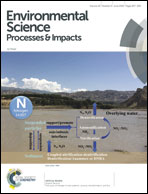Electrochemical oxidation of ciprofloxacin in two different processes: the electron transfer process on the anode surface and the indirect oxidation process in bulk solutions†
Abstract
Herein, the rotating disk electrode technique was used for the first time to investigate the effects of mass-transfer limitations and pH on the electrochemical oxidation of CPX, to determine the kinetics of CPX oxidation and to explore intrinsic mechanisms during the electron transfer process. Firstly, cyclic voltammetry revealed that an obvious irreversible CPX oxidation peak was observed within the potential window from 0.70 to 1.30 V at all pHs. Based on the Levich equation, the electrochemical oxidation of CPX in the electron transfer process was found to be controlled by both diffusion and kinetic processes when pH = 2, 5, 7 and 9; the diffusion coefficient of CPX at pH = 2 was calculated to be 1.5 × 10−7 cm2 s−1. Kinetic analysis indicated that the reaction on the electrode surface was adsorption-controlled compared to a diffusion process; the surface concentration of electroactive species was estimated to be 1.15 × 10−9 mol cm−2, the standard rate constant of the surface reaction was calculated to be 1.37 s−1, and CPX oxidation was validated to be a two-electron transfer process. Finally, a possible CPX oxidation pathway during the electron transfer process was proposed. The electrochemical degradation of CPX on a Ti-based anode was also conducted subsequently to investigate the electrochemical oxidation of CPX in the indirect oxidation process in bulk solutions. The effects of pH and current density were determined and compared to related literature results. The oxidation of CPX at different pHs is believed to be the result of a counterbalance between favorable and unfavorable factors, namely electromigration and side reactions of oxygen evolution, respectively. The effects of current density indicated a diffusion- and reaction-controlled process at low currents followed by a reaction-controlled process at high currents. The results presented in this study provide better understanding of the electrochemical oxidation of CPX and would enable the development of new treatment methods based on electrochemistry.



 Please wait while we load your content...
Please wait while we load your content...